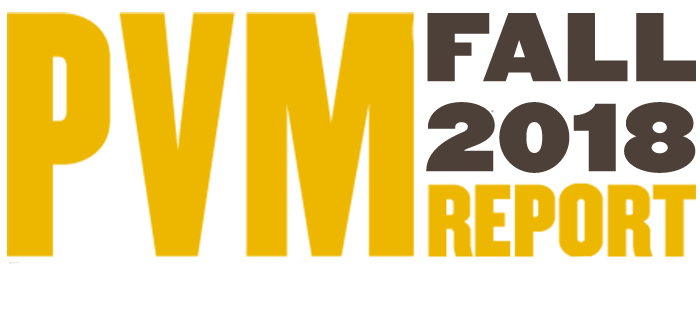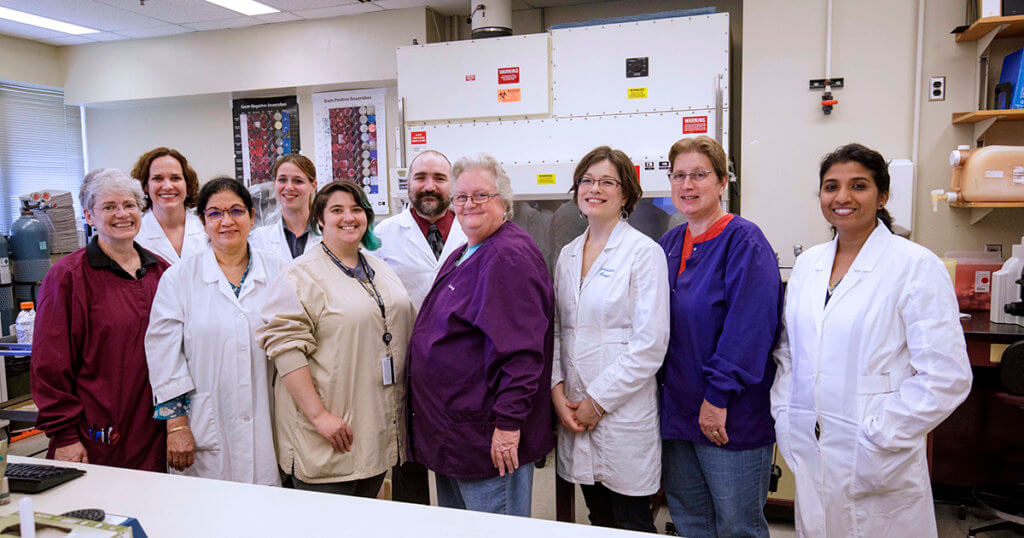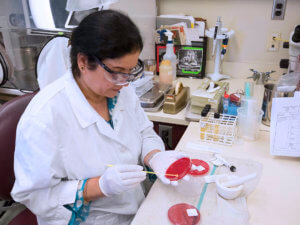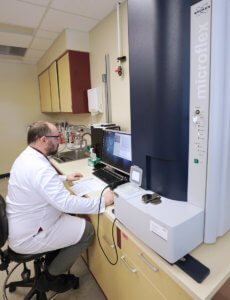
Practical Focus Guides ADDL’s Bacteriology, Mycology, and Parasitology Sections
Make a Gift
Support the College

The bacteriology, mycology and parasitology team: (left-right) Elaine Baird, Kenitra Hammac, Renu Bajaj, Natalia Knowlton, Jessica Joneson, Nathan Simpson, Bonnie Vera, Meggan Stanton, Deb Lubelski and Deepti Pillai.
When Dr. Kenitra Hammac, clinical assistant professor of veterinary diagnostic microbiology, comes to work each day, she has several goals in mind related to the operation of the Indiana Animal Disease Diagnostic Laboratory (ADDL). That’s because, in addition to being a member of the faculty in Purdue Veterinary Medicine’s Department of Comparative Pathobiology, Dr. Hammac also serves as the head of the ADDL sections responsible for bacteriology, mycology, and parasitology. She says most of her goals for the sections are informed by her previous experience in private practice.

Bacteriology Laboratory Technician Renu Bajaj inoculates a blood agar plate with a clinical sample.
“I’m always thinking about what practical approaches we should target to help veterinarians in private practice,” Dr. Hammac said. “I want to help bridge the knowledge gap for veterinarians about what happens in the lab after we receive their samples so they can correctly interpret laboratory reports.”
One such approach involved developing an educational video series that covers what happens in the lab after the ADDL receives an accession. This series was created and funded with a stipend Dr. Hammac received as a Scholarship of Engagement Fellow in 2017. The first video shows how antimicrobial susceptibility testing (AST) is performed in the lab and the second covers interpretations of these laboratory results. Interpretation of antimicrobial susceptibility testing is the most common topic of Dr. Hammac’s conversations with clients. She has plans to address the second most common topic of client consultations, proper sample collection and submission, in a future educational video.

Bacteriology Laboratory Technician Nathan Simpson analyzes a target plate on the MALDI-TOF mass spectrometer for bacterial identification.
The lab sections for bacteriology, mycology and parasitology have grown significantly in the last five years. Parasitology testing, for example, has more than doubled during that time. Under the supervision of Dr. Hammac and Dr. Deepti Pillai, clinical assistant professor of diagnostic microbiology, eight technicians test, process, and interpret data for the presence of bacteria, fungi, and parasites in various ante-mortem and post-mortem samples. The team is continuously improving lab reports to make sure they have practical meaning for veterinarians in practice because this information helps veterinarians identify trends and determine the best treatment and management options for their clients.
“It’s our goal to give veterinarians practical information they can use in their private practices,” Dr. Hammac said. “I want to teach veterinarians what I wish I knew about diagnostic microbiology when I was in practice. It’s our goal to give useful data in a timely manner and be a facilitator for their success.”
Writer(s): Lauren Bruce | pvmnews@purdue.edu

